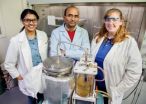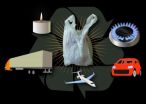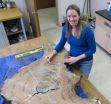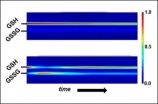(Press-News.org) CHAMPAIGN, Ill. — Plastic shopping bags, an abundant source of litter on land and at sea, can be converted into diesel, natural gas and other useful petroleum products, researchers report.
The conversion produces significantly more energy than it requires and results in transportation fuels – diesel, for example – that can be blended with existing ultra-low-sulfur diesels and biodiesels. Other products, such as natural gas, naphtha (a solvent), gasoline, waxes and lubricating oils such as engine oil and hydraulic oil also can be obtained from shopping bags.
A report of the new study appears in the journal Fuel Processing Technology.
There are other advantages to the approach, which involves heating the bags in an oxygen-free chamber, a process called pyrolysis, said Brajendra Kumar Sharma, a senior research scientist at the Illinois Sustainable Technology Center who led the research. The ISTC is a division of the Prairie Research Institute at the University of Illinois.
"You can get only 50 to 55 percent fuel from the distillation of petroleum crude oil," Sharma said. "But since this plastic is made from petroleum in the first place, we can recover almost 80 percent fuel from it through distillation."
Americans throw away about 100 billion plastic shopping bags each year, according to the Worldwatch Institute. The U.S. Environmental Protection Agency reports that only about 13 percent are recycled. The rest of the bags end up in landfills or escape to the wild, blowing across the landscape and entering waterways.
Plastic bags make up a sizeable portion of the plastic debris in giant ocean garbage patches that are killing wildlife and littering beaches. Plastic bags "have been detected as far north and south as the poles," the researchers wrote.
"Over a period of time, this material starts breaking into tiny pieces, and is ingested along with plankton by aquatic animals," Sharma said. Fish, birds, ocean mammals and other creatures have been found with a lot of plastic particles in their guts.
Whole shopping bags also threaten wildlife, Sharma said.
"Turtles, for example, think that the plastic grocery bags are jellyfish and they try to eat them," he said. Other creatures become entangled in the bags.
Previous studies have used pyrolysis to convert plastic bags into crude oil. Sharma's team took the research further, however, by fractionating the crude oil into different petroleum products and testing the diesel fractions to see if they complied with national standards for ultra-low-sulfur diesel and biodiesel fuels.
"A mixture of two distillate fractions, providing an equivalent of U.S. diesel #2, met all of the specifications" required of other diesel fuels in use today – after addition of an antioxidant, Sharma said.
"This diesel mixture had an equivalent energy content, a higher cetane number (a measure of the combustion quality of diesel requiring compression ignition) and better lubricity than ultra-low-sulfur diesel," he said.
The researchers were able to blend up to 30 percent of their plastic-derived diesel into regular diesel, "and found no compatibility problems with biodiesel," Sharma said.
"It's perfect," he said. "We can just use it as a drop-in fuel in the ultra-low-sulfur diesel without the need for any changes."
INFORMATION:
The research team also included Bryan Moser, Karl Vermillion and Kenneth Doll, of the USDA National Center for Agricultural Utilization Research, in Peoria, Ill.; and Nandakishore Rajagopalan, of the ISTC at the U. of I.
The Illinois Hazardous Waste Research Fund, and the Environmental Research and Education Foundation supported this study.
Editor's notes: To reach Brajendra Sharma, call 217-265-6810; email bksharma@illinois.edu.
The paper, "Production, Characterization and Fuel Properties of Alternative Diesel Fuel From Pyrolysis of Waste Plastic Grocery Bags," is available online or from the U. of I. News Bureau.
Plastic shopping bags make a fine diesel fuel, researchers report
2014-02-12
ELSE PRESS RELEASES FROM THIS DATE:
LA BioMed researchers report on promising new therapy for devastating genetic disorder
2014-02-12
LOS ANGELES – (Feb. 12, 2014) – A promising new therapy has – for the first time – reduced damage to the brain that can be caused by Sanfilippo B (MPS IIIB), a rare and devastating genetic disease, Los Angeles Biomedical Research Institute (LA BioMed) researchers will report today in a presentation at the Lysosomal Disease Network's 10th Annual WORLD Symposium™.
Sanfilippo B syndrome is a lysosomal storage disease belonging to the group of mucopolysaccharidoses (MPS) that is characterized by severe and rapid intellectual deterioration. LA BioMed pioneered the research ...
From artificial to natural, the food industry makes a major shift
2014-02-12
Extracts from algae, rosemary and monk fruit could soon replace synthetic ingredients and food additives such as Blue No. 1, BHT and aspartame that label-conscious grocery shoppers are increasingly shunning. Research is enabling this shift from artificial colors, sweeteners and preservatives to naturally derived ones, and could soon yield many more natural options, reports Chemical & Engineering News, the weekly newsmagazine of the American Chemical Society.
Melody M. Bomgardner, senior editor at C&EN, notes that the trend has built momentum as concern over negative ...
Help for a scarred heart: Scarring cells turned to beating muscle
2014-02-12
ANN ARBOR – Poets and physicians know that a scarred heart cannot beat the way it used to, but the science of reprogramming cells offers hope--for the physical heart, at least.
A team of University of Michigan biomedical engineers has turned cells common in scar tissue into colonies of beating heart cells. Their findings could advance the path toward regenerating tissue that's been damaged in a heart attack.
Previous work in direct reprogramming, jumping straight from a cell type involved in scarring to heart muscle cells, has a low success rate. But Andrew Putnam, ...
San Francisco's big 1906 quake was third of a series on San Andreas Fault
2014-02-12
EUGENE, Ore. -- (Feb. 12, 2014) -- Research led by a University of Oregon doctoral student in California's Santa Cruz Mountains has uncovered geologic evidence that supports historical narratives for two earthquakes in the 68 years prior to San Francisco's devastating 1906 disaster.
The evidence places the two earthquakes, in 1838 and 1890, on the San Andreas Fault, as theorized by many researchers based on written accounts about damage to Spanish-built missions in the Monterey and San Francisco bay areas. These two quakes, as in 1906, were surface-rupturing events, the ...
Clever NIST/JPL technology decodes more information from single photons
2014-02-12
It's not quite Star Trek communications—yet. But long-distance communications in space may be easier now that researchers at the National Institute of Standards and Technology (NIST) and Jet Propulsion Laboratory (JPL) have designed a clever detector array that can extract more information than usual from single particles of light.
Described in a new paper,* the NIST/JPL array-on-a-chip easily identifies the position of the exact detector in a multi-detector system that absorbs an incoming infrared light particle, or photon. That's the norm for digital photography cameras, ...
New NIST method evaluates response to oxidation in live cells
2014-02-12
Researchers at the National Institute of Standards and Technology (NIST) have developed a new method for accurately measuring a key process governing a wide variety of cellular functions that may become the basis for a "health checkup" for living cells.
The NIST technique measures changes in a living cell's internal redox (reduction-oxidation) potential, a chemistry concept that expresses the favorability of reactions in which molecules or atoms either gain or lose electrons. Redox reactions are important to cell chemistry because they regulate many genes and the proteins ...
Popular disinfectants do not kill HPV
2014-02-12
Commonly used disinfectants do not kill human papillomavirus (HPV) that makes possible non-sexual transmission of the virus, thus creating a need for hospital policy changes, according to researchers from Penn State College of Medicine and Brigham Young University.
"Because it is difficult to produce infectious HPV particles for research, little has been known about HPV susceptibility to disinfection," said Craig Meyers, Distinguished Professor of Microbiology and Immunology, Penn State College of Medicine.
Use of disinfectants on HPV in health care settings has been ...
Hollywood failing to keep up with rapidly increasing diversity, UCLA study warns
2014-02-12
When it comes to influential positions in the entertainment industry, minorities and women are represented at rates far below what would be expected given their percentage of the general population, according to a new study done at UCLA's Ralph J. Bunche Center for African American Studies.
In fact, the report shows, the proportion of female and minority actors, writers, directors and producers in films and TV ranges from just one-twelfth to one-half of their actual population percentage.
"The report paints a picture of an industry that is woefully out of ...
Meeting the eye-witnesses of ocean change
2014-02-12
Members of the German research network BIOACID (Biological Impacts of Ocean Acidification) are developing a model that links ecosystem changes triggered by ocean acidification and climate change with their economic and societal consequences. Workshops and interviews with stakeholders from the Norwegian fishing industry and tourism sector, the government and environmental organisations help them to identify key aspects for their assessment.
During the past ten years, scientists have learned a lot about the effects of ocean acidification on marine ecosystems. It has become ...
Cities support more native biodiversity than previously thought
2014-02-12
(Santa Barbara, Calif.) — The rapid conversion of natural lands to cement-dominated urban centers is causing great losses in biodiversity. Yet, according to a new study involving 147 cities worldwide, surprisingly high numbers of plant and animal species persist and even flourish in urban environments — to the tune of hundreds of bird species and thousands of plant species in a single city.
Contrary to conventional wisdom that cities are a wasteland for biodiversity, the study found that while a few species — such as pigeons and annual meadow grass — are shared across ...






